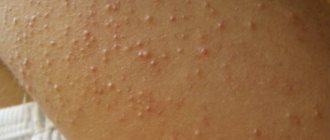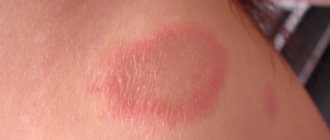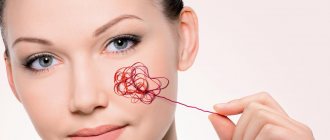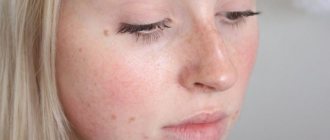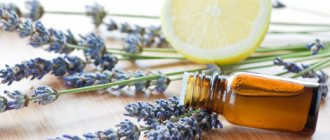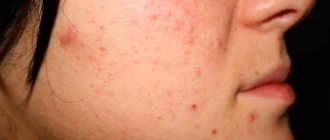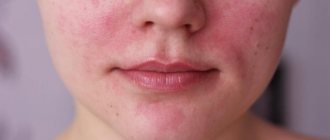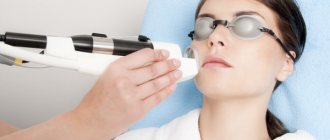What is erysipelas?
A skin disease that is infectious in nature is called erysipelas. The disease is caused by streptococcus.
Streptococci cause an infectious disease - streptoderma. Here you can read about the treatment of streptoderma in adults.
The infection penetrates through injured areas of the skin:
- Cracks.
- Wounds.
- Abrasions.
- Scratches.
Sometimes there are cases of infection through the endogenous route:
- airborne;
- through infected objects;
- food.
In this case, the spread of streptococcus passes through the human lymphatic system.
Provoking factors
The development of erysipelas on the face can be provoked by:
- stress loads;
- long-term fatigue;
- increased sports loads;
- sudden temperature changes;
- mechanical skin defects;
- Tan.
One of the obvious reasons may be:
- Reduced immunity.
- Chronic somatic diseases.
- Unbalanced diet.
- Alcohol abuse.
- Streptococcus infection.
Causative agent of erysipelas and predisposing factors
Staphylococcus aureus and group A streptococcus cause erysipelas of the face. They are pathogenic microorganisms and are widespread, because of this, infection can occur without intermediaries through damaged skin. In addition, the infection can enter the body through the blood.
For the pathogen to be realized, some predisposing factors are necessary. These primarily include:
- alcoholism;
- addiction;
- malignant neoplasms;
- period of chemotherapy;
- exhaustion of the body;
- diabetes mellitus type 1 and 2;
- immunodeficiency states;
- hypovitaminosis;
- dystrophic skin lesions;
- occupational hazards;
- chronic dermatoses with an itchy component.
In order for Staphylococcus aureus to realize itself, the body’s immune forces must be reduced, no matter for what reason, these could be chronic diseases and even addictions. The second essential element in the spread of infection is microtrauma, they can be in the form of scratches or even cuts, that is, any damage to the protective skin.
A separate group includes postoperative erysipelas, which occurs after surgical interventions. Cancer patients with weakened immune systems and other aggravating factors are most often at risk.
What does a erysipelas look like on your face?
The disease “erysipelas” on the face is often expressed through visual signs:
- Disruption of lymph flow, as streptococcus affects the lymphatic vessels.
- Cracks appear.
- Soreness in inflamed areas.
- A red spot appears that rises above the level of the skin.
- Erysipelas on the face always have clearly defined boundaries.
- After some time, the spot grows and becomes hot.
- In advanced stages, blisters and hemorrhages may appear.
With erysipelas located in the face area, the inflammatory process can spread in the following areas:
- ears;
- nose;
- ear opening;
- mouth;
- cheeks;
- rarely located under the hairline.
In another article you can see what erysipelas on the leg looks like.
Photo
To determine the visual symptoms of erysipelas, use the provided photographic material.
What kind of disease is this
This pathology - the disease erysipelas on the face is infectious, manifested by cavities with serous fluid - vesicles, or damage to the blood vessels of the face with the formation and release of fluid from them. Often accompanied by a sharp increase in body temperature and general poisoning of the body. Inflamed skin becomes covered with dark red spots with a predominance of red blood cells, turning into blisters with purulent fluid. Inflamed skin also tends to become covered with something similar to a marble pattern, while it is exposed to necrotic effects, causing an acute purulent inflammatory process of the subcutaneous tissue. Without paying due attention to erysipelas, it can affect internal organs, in particular the digestive tract.
Erysipelas is such a pathology that many carriers of the infection do not even suspect that they are its carriers, while not suffering from skin inflammation. Close contact with them and airborne secretions can transmit streptococcus to the people around them. Having settled on the skin and mucous membranes, spherical bacteria begin to become active in the new organism. This is facilitated by small cracks, diaper rash, and abrasions of the skin, which serve as gateways for the penetration of microbes. Doctors have noted an increase in morbidity due to frequent, prolonged stress, which significantly weakens the immune system, and erysipelas of the facial skin is a common result.
Symptoms
The initial symptomatic manifestations of erysipelas are:
- headache and general weakness;
- temperature rise up to 40 degrees;
- aches in the joints, lower back, muscles;
- burning sensation;
- itching;
- gagging;
- swelling in the damaged area;
- tachycardia.
There may be pain in the scalp, often in inflamed areas.
In severe conditions the following are observed:
- vomit;
- convulsions;
- rave.
Medicinal treatments
It is possible to restore skin surfaces and cure erysipelas on the face using a wide range of medications. How therapy is carried out effectively:
- Antibiotics - “Erythromycin”, “Clindamycin”, “Oleandomycin”, as well as vitamins and antihistamines. At home you can use Ciprofloxacin and Doxycycline tablets. In a hospital setting, intramuscular injections of penicillin are used predominantly.
- Anti-inflammatory drugs - Butadione, Chlotazol. They are prescribed in the presence of severe swelling that causes pain. It is recommended to use for at least 2 weeks.
- Solutions for intravenous administration - “Hemodez”, glucose, sodium chloride. It is necessary to administer drugs only when the disease reaches a threshold value.
Important. Ointments containing an antibiotic, as well as, for example, Vishnevsky ointment, should not be used for treatment, since the warming effect can worsen the course of the disease.
Treatment with antibiotics in the form of injections is carried out in a hospital and lasts 7-10 days
Forms of erysipelas
There are several classifications of erysipelas.
Depending on the frequency of occurrence, there are varieties:
- Primary. The patient is diagnosed with the disease for the first time. It most often affects the face area.
- Repeated erysipelas. Occurs repeatedly, localization can be varied.
- Recurrent. The manifestation of the disease can be early or late. Localize both in new zones and meet in old places.
According to the degree of progression, erysipelas is divided into the following stages:
- Easy stage. It is short-term, its development takes from 1 to 3 days. Characterized by:
- high body temperature;
- moderate intoxication;
- erythematous skin lesions.
- Medium-heavy. It also occurs quite quickly; this stage takes up to 5 days. Expressed:
- high body temperature;
- general weakness;
- severe headaches;
- has extensive areas of inflammation.
- Heavy. The longest stage of the erysipelas process on the face. Often this stage is complicated by infectious lesions:
- sepsis;
- pneumonia;
- infectious-toxic shock.
There are also several forms of erysipelas depending on the nature of the local manifestation:
- Erythematous erysipelas. With this form of erysipelas, symptoms are observed: the affected area has redness, swelling is observed, and the affected area is painful. Visually this form can be distinguished:
- Has a bright color.
- Clear outlines.
- The inflammation can grow and rise above the skin level.
- The edges take on an irregular shape.
- Peeling of the skin appears.
- Erythematous bullous erysipelas. This form has similar symptomatic features. However, after 3 days the following symptoms are observed:
- detachment of the upper layer of the skin occurs;
- bubbles with transparent contents form;
- after the formations burst, a brown crusted formation appears;
- in the area of the former vesicles, erosions are observed, which, without treatment, develop into trophic ulcers;
- There are phenomena of intoxication and lymphadenitis.
- Erythematous-hemorrhagic erysipelas. This form of erysipelas is expressed through hemorrhages in the area of the inflammatory process. Symptomatic signs added:
- hemorrhages;
- duration up to two weeks;
- fever;
- the development of necrotic lesions on the skin is possible.
- Bullous-hemorrhagic erysipelas. A distinctive feature of this form of erysipelas and erythematous-bullous is the formation of bloody filler inside the blisters. Refers to the most severe forms of erysipelas. Symptomatic manifestations include:
- vascular damage;
- there is serous-hemorrhagic content inside the vesicles;
- after the blisters open, erosions may form;
- the blisters can leave behind scars.
You might be interested! Scabies in adults: first signs, photos and treatment
There is a classification of erysipelas and inflammatory processes according to the distribution of forms of local manifestation:
- Localized. The source of spread does not extend beyond one zone. For example: face, legs or back.
- Common. Erysipelas are observed in several places at the same time.
- Migratory. In one place the pathological process may subside, while in another there is an increased development of inflammation.
- Metastatic. Pathological areas may be located far from each other.
Infection process and symptoms
Staphylococcal bacillus lives freely in public places, so anyone can get erysipelas. There is also a high probability of developing the disease through direct contact with a patient:
- Infection occurs through damaged tissue of the upper layer of the epidermis. Even a minor wound can become an excellent environment for the development of inflammation.
- During pregnancy, during periods of illness, constant stress and physical activity, the functioning of the immune system is disrupted, during which time the body can become infected.
- The incubation period is 24 hours.
Important: Treatment of inflammation must begin as soon as possible; if you do not seek specialized help in time, the disease can cause sepsis.
Main symptoms:
- From the first day of infection, a sharp increase in body temperature is observed to the maximum permissible (39-40 degrees).
- Chills and tremors often appear.
- Pain often occurs in the area of the lymph nodes.
- Weakness, muscle pain, and headache appear.
- There is a disturbance in the digestive system, nausea and vomiting.
- In severe cases, seizures may occur.
- Characteristic red spots appear on the body, which very quickly increase in volume. The appearance of erysipelas is first accompanied by itching and burning, then the site of inflammation begins to ache and “burn.”
- In the area where swelling occurs, the skin is raised and often begins to peel off.
- When pressed, the skin turns white for a few seconds.
- In most cases, the inflamed area of skin becomes red, but there are exceptions. The spots have clear outlines and uneven boundaries.
- When touched, unbearable pain is felt, the skin differs significantly in temperature - it “burns”.
- The spot may become covered with blisters filled with clear, bloody or purulent fluid.
- Sometimes hemorrhages and bruises occur.
- Most often, erysipelas is localized on the face, ear area and lower extremities. Less common on the head and other areas.
- The disease is accompanied by arrhythmia.
- Even with proper treatment, the disease is accompanied by a fever that lasts more than a week.
- With proper treatment, the spots disappear within a couple of weeks.
Erysipelas in the area of the ear canal and ear is accompanied by severe swelling and terrible pain.
Important: Treatment is always effective, but there is a risk of relapse. When the disease recurs, there is no fever. Relapse may occur within 2-3 years.
Treatment
Complications observed with erysipelas:
- rheumatism;
- sepsis;
- nephritis;
- myocarditis;
- abscess;
- elephantiasis of the limbs.
Therefore, timely diagnosis and treatment of this skin lesion is necessary.
Diagnostic criteria for identifying erysipelas are:
- Acute onset of the disease.
- The severity of symptomatic intoxication.
- Erysipelas mainly spreads in the face area, less commonly in the limbs.
- Local lymphadenitis may develop.
- Development of erythema.
- Absence of pain in the affected area during periods of rest.
Very often, erysipelas has similar symptomatic manifestations to:
- abscess;
- phlegmon;
- erythema nodosum;
- eczema;
- herpes zoster;
- thrombophlebitis.
Drug treatment.
The causative agent of erysipelas is hemolytic streptococcus.
To combat infection, antibacterial drugs of various groups are used:
- penicillins;
- sulfonamides;
- nitrofurans.
Prescribed medications such as:
- oleandomycin;
- erythromycin;
- ampicillin trihydrate;
- clindamycin.
Various combinations of dosage forms may be prescribed.
The therapeutic effect is expressed as follows:
- body temperature decreases;
- inflammatory areas turn pale;
- skin cleansing occurs after 3 days.
Local medications are also prescribed:
- powders such as enteroseptol;
- ointments made from crushed tablet medications;
- erythromycin ointment.
Antihistamines and non-steroidal medications are also prescribed.
In severe forms, the following are possible:
- blood transfusion;
- administration of placental gamma globulin;
- vitamin complexes;
- biostimulants: levamisole, methyluracil, pentoxyl.
Physiotherapy
Physiotherapy is prescribed to reduce inflammation in pathological areas, as well as to reduce the severity of intoxication.
Such manipulations include:
- ultraviolet irradiation, which has an antibacterial effect;
- drug electrophoresis;
- UHF therapy, the use of electromagnetic waves on the affected areas. It is also used to get rid of boils on the body. Here you will find in more detail the answer to the question about the causes, treatment and photos of furunculosis.
- Microwave therapy, treatment of the zone with electromagnetic frequencies.
Surgery
When treating bullous forms, the use of local antiseptics does not have the desired effect, but can only increase exudation and inhibit the healing process.
When the disease develops, the following have a good effect:
- cryodestruction;
- quartzing;
- laser therapy.
Causes
It is believed that the manifestation of skin inflammation is most associated with the summer and autumn months of the year. However, an increased amount of glucose in the blood, mycotic fungal problems of the feet, inflammation of the lymph nodes, painful dilatation of the veins are significant factors for reducing immunity, contributing to the occurrence of erysipelas. To this can be added inflammation of the walls of venous vessels with the formation of blood clots.
The causes of erysipelas of the facial skin are the following factors:
- hormonal disorders as a result of pregnancy, puberty, postpartum, menopause;
- hereditary, genetic predisposition;
- lack of fresh fruits and vegetables in the diet, predominance of fatty, carbohydrate foods;
- sedentary, sedentary lifestyle;
- the use of tight underwear that interferes with blood flow to the skin;
- long-term constant mental stress, alcohol addiction;
- negative ecology.
Prevention
Since erysipelas is a contagious disease, it is necessary to reduce or cancel all contacts with infected people. Family members should prevent injuries to the skin and monitor the sanitary and hygienic condition of the skin.
For preventive purposes, it is better to adhere to certain rules:
- promptly treat all painful conditions of the skin;
- observe personal hygiene rules, especially after visiting crowded places;
- do not allow infectious agents to get into small scratches or wounds;
- treat all violations of the integrity of the skin.
- timely treatment of fungal skin infections and lymphovenous insufficiency.
Treatment of erysipelas on the face with folk remedies
Erysipelas, which at first glance may seem like an allergy or irritation, over time becomes a real problem. If you initially use effective folk remedies to treat erysipelas, the healing process will go much faster. It should be remembered that many remedies have negative side effects, so you need to carefully monitor your well-being while using them.
Treatment of erysipelas with folk remedies is one of the safest ways to eliminate the disease, because traditional medicine practices antibiotic therapy, which have a negative effect on internal organs . This inflammatory skin pathology is quite common; its peculiarity is that erysipelas can appear in any person, regardless of age or gender.
Erysipelas is considered a life-threatening disease, which is accompanied by various symptoms that worsen the general health of the patient. Also, the disease can be accompanied by relapses, and after some time a person who has recovered from the disease is again exposed to it.
Erysipelas is caused by staphylococcus. The scalp is most often affected.
Treatment with folk remedies for erysipelas is also a preventive measure that will suppress the disease. The affected area of the body is an excellent place for the introduction of pyogenic microbes, which can lead to the development of severe complications.
Note! It is very important to consult a specialist at the first manifestations of erysipelas in order to prevent the disease from progressing.
Antibiotics have proven themselves to be excellent in the fight against erysipelas, because they not only quickly relieve inflammation, but also kill pathogenic microbes. However, such treatment may have side effects, which is why folk remedies for erysipelas are very popular.
- 1 tsp. honey;
- 1 tbsp. l. chamomile;
- 1 tbsp. l. coltsfoot.
- Grind the plants.
- Mix with honey until smooth.
- Rub the mixture into the affected skin.
Honey in addition to chamomile and coltsfoot is very effective in treating erysipelas
- 0.5 l of water;
- 1 tbsp. l. dandelion;
- 1 tbsp. l. nettle;
- 1 tbsp. l. calendula;
- 1 tbsp. l. blackberries;
- 1 tbsp. l. horsetail;
- 1 tbsp. l. oak bark.
- Mix all ingredients.
- Bring water to a boil.
- 4 tbsp. l. pour boiling water over the mixture.
- Leave for 20 minutes.
- Wash your face with the product 3-4 times a day.
Treatment of erysipelas at home can be done with the help of hawthorn. The berries need to be ground into a paste, applied to the wound, and secured with a bandage.
Honey tincture with vodka is also excellent for treating erysipelas at home.
- Mix vodka with honey.
- Leave for 2-3 hours.
- Soak gauze in the solution.
- Apply to the wound for 1 hour.
- The procedure should be carried out 3 times a day.
If you need to treat erysipelas on your legs at home, you should pay attention to this remedy: squeeze the juice out of potatoes. Soak gauze in potato juice and apply it to the inflamed area overnight.
Potato juice helps eliminate erysipelas
Note! In folk medicine for erysipelas, there are many recipes. However, they should be used only after consultation with your doctor.
To treat this disease, you can use plantain compresses. The plant does not cause allergic reactions, with the exception of individual intolerance. You should crush a few plantain leaves and apply them three times a day to the inflamed area.
Treatment with folk remedies for the disease “hemorrhagic erysipelas” is possible with the help of a healing herbal infusion.
- 1 tsp. eucalyptus;
- 1 tsp. yarrow;
- 1 tsp. burnets;
- 1 tsp. calamus;
- 1 tsp. nettle;
- 600 g of water.
- To boil water.
- Place all ingredients in a glass jar.
- Pour boiling water over it.
- Leave for 3 hours.
- Take 50 ml orally 4 times a day.
Herbal infusions have proven themselves to be effective traditional medicines.
Note! Treatment of erysipelas with folk remedies in people suffering from diabetes should be carried out carefully. To do this, you must definitely consult with a specialist.
- 4 tbsp. l. Vaseline;
- 1 tbsp. l. elecampane.
- Grind elecampane to a dusty state.
- Mix with Vaseline.
- Rub the product 2 times a day onto the affected area.
- 2 leaves of fresh burdock;
- 1 tbsp. l. sour cream.
- Pass the burdock through a meat grinder or grind using a blender.
- Add sour cream.
- Apply the mixture to the inflamed skin for 20 minutes, covering it with a red cloth on top.
A mixture of crushed burdock and sour cream is an effective means of combating erysipelas.
Note! Treatment of erysipelas with folk remedies using a red rag is widely used by healers, but this method cannot be called an effective therapy, since its effectiveness has not been fully established.
Treatment with folk remedies for the disease “erysipelas” can occur with the help of propolis. This product has many beneficial properties and easily eliminates the disease. Based on propolis, you can prepare various ointments for external use, each of them is unique. Only a specialist can choose the right ointment.
Treatment with folk remedies for erysipelas is quite effective and requires minimal financial costs. It should be remembered that traditional therapy is most effective as an addition to drug treatment.
source
Erysipelas is an acute infectious skin disease caused by group A streptococci. The disease is prone to recurrence, and if the primary erysipelas most often appears on the face, the recurrent disease is usually localized in areas with chronic diseases of the lymphatic or blood vessels - usually on the lower extremities .
Erysipelas has been known for a very long time, so there are many recipes for combating the disease, but it is worth remembering that traditional medicine is only a supplement to the main therapy.
Erysipelas is a very common streptococcal infection. It ranks 4th after acute respiratory, intestinal infections and viral hepatitis.
The causative agent of the disease is any beta-hemolytic streptococcus of group A. Its source is any carrier of infection - contaminated instruments, dressings, and a patient with any form of streptococcal infection. It is transmitted by contact and airborne droplets through abrasions, minor injuries, and abrasions.
Streptococci are very common in nature. Every person's skin contains a certain amount of these bacteria. Provided that the immune system is functioning adequately, infection does not occur, but when the immune system is weakened due to chronic diseases, erysipelas develops unhindered. This explains the prevalence of infection among elderly patients.
Erysipelas is extremely rare in children, but poses a great threat. When infected, the disease very quickly spreads to the buttocks, back, lower limbs and leads to very high intoxication of the body. The mortality rate for newborn erysipelas is very high.
- Streptococci penetrate through damage into the lymphatic vessels and capillaries, causing swelling, erythema, and cellular infiltration of the skin. As a rule, edema is accompanied by increased fragility of blood vessels, which provides numerous edematous hemorrhages. The development of the disease is directly related to disturbances in the functioning of the immune system - against the background of reduced production of T-lymphocytes and increased immunoglobulin E. Under such conditions, an allergy is formed: the occurrence of secondary inflammation in the same area indicates the allergic nature of the skin restructuring and its sensitization to streptococcus. As recent studies show, staphylococcal microflora is also involved in the development of the disease, especially when it comes to the recurrent form. This should be taken into account when prescribing treatment.
- Obviously, it is possible to fight streptococcal infections only with the help of a certain type of antibiotics: erythromycin, penicillin, clindamycin. It is also obvious that folk remedies are powerless in the fight against pathogenic microflora, but they are a good means of symptomatic treatment. Decoctions and compresses help relieve swelling, itching and prevent the spread of the disease.
Cases of complete recovery in patients using only folk remedies, alas, are explained by the patient’s initially high immunity. That is, an infection that has penetrated inside provokes the release of the required immunoglobulin. The latter, when produced in sufficient quantities, suppresses the disease. At the same time, antibodies are produced that prevent re-inflammation from developing.
As the immune system weakens, the picture changes. The disease not only cannot be cured without antibiotics, but also progresses to a more severe stage - blisters with serous contents appear, and lymphostasis may develop. In addition, the likelihood of a secondary infection is very high. It is worth considering the consequences of intoxication.
The video below will tell you whether folk remedies help with erysipelas:
Traditional recipes are mainly aimed at reducing symptoms - swelling, soreness, fever, inflammation. In addition, the treatment is facilitated by decoctions of herbs that enhance immunity. The latter are also used in the prevention of relapses.
General recommendations for treatment include the following:
- daily shower is a must. However, the affected areas are washed very carefully, only with warm water - not hot, and without using a sponge;
- dry the skin with napkins, do not wipe;
- Your daily diet should include fermented milk products - kefir, yogurt, yogurt, as fresh as possible. Lactobacilli help restore normal intestinal function, and the latter is precisely the “base” for the synthesis of the corresponding immunoglobulins;
- lubricate inflammation with fatty creams and ointments to minimize contact with moisture;
- In case of illness, the sun turns into a medicine, that is, it is taken in doses: the affected skin can be irradiated with ultraviolet light for no more than 15 minutes a day.
Erysipelas on the legs is most often secondary, but the disease can begin here too.
The “gateway” for infection is fungal infection of the foot, trauma, and calluses. A prerequisite for the development of the disease is a decrease in immunity. The appearance of erysipelas on the legs during relapses is associated with the characteristics of the disease itself: erysipelas “prefers” foci of existing chronic inflammation, areas with disturbances in blood circulation, and lymph stagnation. It is on the legs that varicose veins and thrombophlebitis most often develop, which is an ideal soil for erysipelas. People whose profession requires them to stand for long periods of time often fall victim to the disease, and their weakened immune system no longer provides adequate protection.
To treat erysipelas on the legs, both creams and lotions are used.
- The burdock leaf is kneaded into a paste and mixed with a small amount of sour cream. The mixture is applied to the damaged area and left for at least 2-3 hours.
- Crushed plantain leaves are mixed with honey and heated over low heat. The mixture is cooled and used as a compress. The composition relieves inflammation well and reduces pain.
- A compress of potato juice helps relieve swelling and inflammation. They keep him there all night.
- For varicose veins, it is useful to use a cabbage compress. To do this, knead the cabbage leaf, grease it with olive oil and apply it to the inflamed area. The compress is secured with a bandage and held for 3 hours.
- Twice a day it is recommended to lubricate the skin with a mixture of equal parts of sea buckthorn oil and aloe juice.
Ancient healing methods can also help with erysipelas, as the video below will tell you about:
- The appearance of erysipelas on the hand is usually associated with drug use. Streptococci enter the lymph system through traces of injections, and therefore this disease is most often observed in men 20–35 years old. Erysipelas on the hands is rarely associated with occupational injuries and illnesses.
- In women, erysipelas can result from removal of the mammary gland. At the same time, lymph often stagnates in the hand, which creates favorable conditions for the development of the disease.
For treatment, both the above remedies and more specific ones are used.
- A hawthorn compress is prepared as follows: grind the juicy fruits into a paste, apply to the skin and secure with a bandage. The composition is retained for several hours.
- A compress made from a mixture of vodka and honey in equal parts quite successfully relieves inflammation and swelling. A piece of bandage is soaked in the mixture and held on the hand for at least 1 hour. The procedure is repeated three times a day.
- You can use camphor oil. The oil is heated in a bottle, gauze is moistened in the warm liquid and applied to the affected area for 2 hours. After removing the compress, the remaining oil is removed with a paper napkin, and a burdock leaf is applied to the site of inflammation. The compress is repeated 3 times a day.
- 30% propolis ointment is prepared as follows: 1 kg of propolis is ground, poured with 300 ml of pure alcohol and boiled until the propolis dissolves. Then 200 g of Vaseline is melted in a water bath and 50 g of propolis alcohol solution is added to the mass. The composition is mixed, cooled, filtered through cheesecloth and stored in glass containers. The ointment is applied twice a day to the area of inflammation.
- Chalk, or rather its mixture with crushed sage leaves in equal parts, acts as a kind of absorbent that reduces inflammation. This paste is applied to the inflammation 4 times a day and bandaged.
Primary erysipelas is most often observed on the face. The provoking factor in this case is various chronic blockages - conjunctivitis, otitis media, sinusitis, as well as inflamed acne. Localization is associated with the disease:
- With conjunctivitis, the disease develops around the eye sockets.
- When a streptococcal infection appears in the sinuses, erysipelas affects the cheeks and nose - inflammation in the form of a “butterfly”.
- With otitis media, swelling and redness appear around the ears, on the neck, and scalp.
Erysipelas on the face are always accompanied by severe swelling and pain. In this case, you cannot use effective decongestant ointments, as this increases the risk of inflammation. Relatively weak folk remedies turn out to be more useful.
- Coltsfoot and chamomile flowers are crushed, mixed in equal proportions, and honey is added. The mixture is applied to the affected areas.
- Elecampane root is ground, mixed with petroleum jelly in a ratio of 1:4 and applied to the face twice a day.
- Juice from chamomile and yarrow leaves is mixed with butter in a ratio of 1:4. The ointment is applied to the affected area three times a day.
- For erythematous erysipelas, the inflamed areas are lubricated with pork fat every 3 hours.
- For the bullous form - the appearance of blisters, use a mixture of equal parts of crushed plantain, burdock and Kalanchoe. Fresh leaves are ground into a paste and placed on the inflamed area and secured with a piece of gauze. Keep as a mask for at least 1 hour.
- Herbal remedies that reduce inflammation and remove toxins help with erysipelas.
- Dry crushed leaves are mixed in equal parts: yarrow, calamus, burnet, eucalyptus. Part of the collection is poured with 10 parts of boiling water and left for 3 hours. The infusion is filtered and taken 4 times a day, 50 drops.
- For washing, as well as for the purpose of preventing the spread, decoctions of string, chamomile and coltsfoot are used. This herb has pronounced antibactericidal properties and prevents the addition of a secondary infection.
Erysipelas is a serious infectious disease that requires treatment with antibiotics. Folk remedies alleviate the symptoms of the disease and prevent the spread of the disease, but only if they are correctly combined with drug therapy.
Many good recipes for erysipelas are given in this video:
source
. CLASSICS - RED CLOTH AND CHALK
1. 2003 No. 11, 26. She cured erysipelas twice - at 66 years old and 86 years old. Now it's 87. Clean the dust with a knife using regular piece chalk. Spread clean paper on the table, chop the chalk into pieces on it and roll it into fine powder with a bottle. Sprinkle your foot with a thick layer of powder and wrap it tightly with a bright red cloth. Insulate the top with a terry towel (or woolen scarf) and go to bed. Overnight, the compress relieved the temperature and gradually removed the bluish color and redness. As a rule, everything went away after 3-4 days.
2. 2003 No. 17, 25-26. Cured erysipelas of the skin. Mix ground chalk with egg whites until creamy. Apply it evenly on red cloth and apply to the sore spot. Carefully wrap the top with a woolen scarf. After 3 days, change the bandage.
3. 2003 No. 18, 23. Cured erysipelas. On a red woolen rag (synthetics are not suitable!), lay out the petals of the Golden Ball flower in an even layer, you can dry them. Cover the sore spot with this bandage and secure with an elastic bandage. After 2 weeks of this treatment, I forgot about erysipelas.
4. 2005 No. 7, 23. From erysipelas on the leg. Take a red cotton cloth and sprinkle white chalk on it. Apply the fabric to the sore must, without spilling the chalk, and bandage tightly with an elastic bandage. Change the bandage morning and evening. After each procedure, wash and iron the bandage. It takes a long time to heal.
5. 2006 No. 2, 13. Dermatologist Chistyakova I.A. Erysipelas. Cut a palm-sized piece of red silk into small, small pieces and mix them with natural honey. Divide the mixture into 3 parts. In the morning, 1 hour before sunrise, apply a bandage to the wound and bandage it. Do it until you recover.
6. 2006 No. 9, 33. Recipe from a healer grandmother. From erysipelas. Prepare a piece of red calico fabric the size of a scarf. Grind white school chalk into powder (using a bottle) and pour it evenly onto the fabric. Wipe the affected area with camphor oil and, while reading a prayer, apply a bandage. Do the procedure daily. Do not change the fabric, just add chalk. Until recovery.
7. 2006 No. 24, 30. Erysipelas was cured. My leg became very inflamed and became like an elephant’s. Rub the cabbage leaf with soap, apply it to the affected area and wrap it in a red cloth. Do the procedure at night until recovery. After several compresses everything went away.
1. 2005 No. 6, 26. From erysipelas. 1 day. Apply unrefined sunflower oil to the sore spot and place a cabbage leaf on top. Wrap in cellophane and bandage. 2-4 days. After 24 hours, bandage, but use yogurt or kefir instead of butter. Bandage this at least 3 times. 5 days until cure. Then mix 30g of Vaseline with 2g of streptocide and apply a thin layer to the sore spot, topped with a cabbage leaf, cellophane and a bandage. Treat with this ointment until complete recovery. It took me 3 weeks. Take only white cabbage, take a fresh leaf for each dressing, wilt it before applying it and cut off the veins from it. Store the leaves in the refrigerator. Do not wash off the ointment, but wipe it with a cotton swab. Store the ointment in a dark place at room temperature.
2. 2003 No. 20, 25-26. Erysipelas. Cases of treatment using dressings with ichthyol ointment. The veterinarian also writes about cases of cure with the help of pig anti-erysipelas serum (for pigs against erysipelas).
COMPLEX TREATMENT 1). 2003 No. 4, 21. Treatment of erysipelas. I treat with very hot saline dressings with a 10% salt solution. I keep it on for 8-10 hours. You can't miss a single evening without putting on a bandage. At the same time, it is good to drink hydrogen peroxide (according to Neumyvakin). I realized that I need to cleanse the lymph. Eucalyptus infusion also helped. Pour 20 g of dry eucalyptus into 1 liter of boiling water, leave until cool. Strain. Drink 50g 20 minutes before meals for 3 weeks.
2). 2007 No. 18, 16-17. Professor L.V. Pogorelskaya. Erysipelas of the skin. For 5-7 days, take antibiotics - erythromycin, penicillin, combining them with immunocorrectors. In case of severe pain and burning, lubricate the red spot with camphor alcohol, Kalanchoe juice, and plantain juice. Sometimes for lotions they add 0.5% novocaine or dimexide 1:1. If blisters appear, make 2-3 dressings at intervals of 2-3 days with a solution of rivanol, furatsilin or chlorophyllipt. If pus appears, apply gauze and Vaseline bandages with solcoseryl. Change 2 times a day. In chronic recurrent forms of erysipelas, herbal medicine plays an important role: 1. Alcohol and oil solutions of chlorophyllipt (=eucalyptus!). Drink 25 drops + 1l. water 2-3 times a day for 10 days. If there is no allergy. Apply to affected areas 2-3 times a day for 15-20 minutes for 10 days. 2. Rotokan (= alcohol solutions of chamomile, calendula and yarrow 2:1:1) apply externally. 3. Sangviritrin tablets (= macleia herb) are an antimicrobial agent. Dilute 20 tablets in 100 ml of hot water (0.1% solution). Rinse problem areas with it. Or make bandages with it 1-2 times a day. 4. The collection proved to be very effective. Mix equal parts of calamus rhizomes, burnet and licorice roots, eucalyptus and nettle leaves, yarrow and dried grass. Infusion at a concentration of 1:10 or 1:20. Drink 20-50 ml warm 4 times a day. Course 7-12 days. At the same time, drink tincture of Eleutherococcus (or Aralia Manchurian) 10-20 drops 1 time a day - in the morning for 1 month. All of the herbs listed can be used in collections or separately, independently or in complex treatment. 5. Mix 4 parts each of eucalyptus leaves and St. John's wort, 3 parts each of birch buds, cudweed grass and horsetail, 2 parts yarrow. Pour 1 tbsp. collect 1 cup of boiling water and leave for 30 minutes. Strain. Drink 0.5 cups 2 times a day after meals. For recurrent erysipelas, treatment is supplemented with sanguinithrine 0.005 g 3 times a day before meals. Course 1 month. For acute manifestations of erysipelas, make compresses with an infusion of the listed herbs, changing them every 30 minutes. After applying ointments (erythromycin, zinc, wild rosemary) in the evening, wipe the affected areas with apple cider vinegar and rotokan. 6. When treating externally, take into account the slight vulnerability of the skin! Alternate medications every 3 days, especially at the beginning of treatment. The most useful are plantain juice, salvia, chlorophyllipt, rotokan, tincture of valerian, eucalyptus, chamomile, chaga, and lemongrass. In the first 2-3 days of treatment, it is better to dilute these herbal remedies in warm boiled water 1:2. Then switch to undiluted drugs. For recurrent forms of erysipelas, check the degree of drug tolerance. Apply the drug diluted 1:2 to a 2 by 2 cm area of skin and check the result after 2 hours. If redness appears, remove the product! After applying liquid tinctures or extracts, you can move on to using vegetable oils. The best is sanguiritrin liniment, followed by ointment oils with calendula, chamomile, kalanchoe, and horse chestnut. To prepare ointments, pour the raw material with vegetable oil (olive!), covering the grass, and leave for 2-3 weeks. You can use the resulting oil for no more than 3 days. Alternate oils, removing remnants of previous ones. 7. Chronicles should especially carefully study the factors that provoke the disease. Cure otitis media, caries, sinusitis. Usually combined with erysipelas are fungal infections of the feet, diabetes mellitus, obesity, chronic venous insufficiency, thrombophlebitis, and eczema.
1. 2004 No. 4, 8. 2003 No. 20, 17. Recipe by B.V. Bolotov. For erysipelas, lupus erythematosus. Pre-oxidize the body. Cover the sore spot with cloth (overcoat) - to avoid burns, heat the soldering iron red-hot and bring it to the surface of the skin for 30-60 seconds. The wound will be irradiated with electrons. Then the irradiation site must be lubricated with 9% table vinegar, aqua regia, fatty herring, and salt dressings must be applied, moistening them with the same aqua regia. Do everything alternately: first - irradiation, then - lubricate with vinegar, then - herring, then - apply a salt bandage. Tested for effectiveness! REVIEW. 2006 No. 4, 22-23. Experience of healing with this method.
2. 2005 No. 25, 15-16. Doctor Kapustin G.A. With erysipelas. Mix the freshest chicken egg (laid the day before is not suitable) with saline solution 1:3, i.e. for 1 egg – 150 cm³ of solution. Can be stored in a sterile glass, covered with a sterile napkin, for no more than 2 hours. The standard dose for adults is 5 cm³. Technology: treat the shell of a freshly laid egg with alcohol, break it with a sterile spatula, enlarge the hole by breaking off the inside with sterile tweezers. Shake the contents of the egg into a sterile glass, stir with a stick, gradually add 150 g of saline and stir until a uniform milky-yellowish liquid is obtained. Draw the mixture into a sterile syringe and insert the needle. Inject intramuscularly, treating the injection site with alcohol. The usual course of treatment is 8 injections. Contraindication: weak heart function. 3 injections were enough. 2005 No. 3, 9. I was cured of erysipelas of the lower leg by injections with a chicken egg according to Dr. Kapustin’s method. 3 injections were enough.
source
Erysipelas, or erysipelas, is an acute disease accompanied by inflammation of the skin, fever and intoxication.
The cause of the disease is streptococci that penetrate through microtraumas of the skin into the lymphatic vessels, thus causing inflammation.
Erysipelas is an infectious disease that primarily affects the skin. Its course is accompanied by symptoms of general intoxication and frequent relapses. The source of infection with this disease is a person who is a carrier of streptococcus, the causative agent of erysipelas. The infection can enter the body through minor damage to the skin and mucous membrane, for example, scratches, cracks, etc.
The main condition for the occurrence of the disease is a decrease in the body’s immune forces under the influence of unfavorable factors.
Women and older people are most often affected by the disease. After an illness, immunity does not arise.
The onset of the disease is characterized by an increase in body temperature to 39-40 ° C, chills, and symptoms of general intoxication. In this case, the patient complains of weakness, headache, muscle pain, nausea, and vomiting. A few hours after the onset of the disease, pain, itching, burning sensation, swelling and redness of the skin are noted in the affected area. The red spot in the affected area quickly increases in size.
The main areas affected by erysipelas are the face (nasolabial folds, bridge of the nose, cheeks, corners of the mouth) and the scalp. Very rarely, inflammation can occur on the legs and other areas. In some cases, there may be the formation of blisters filled with liquid contents at the site of the red spot, which burst, followed by the formation of crusts. Skin changes persist for 5-15 days.
Symptoms:
the disease usually begins acutely and occurs at a high temperature with chills and fever, which are accompanied by headache, severe weakness and muscle pain, nausea and vomiting. A small reddish or pink spot appears on the skin at the site of the lesion, which then spreads over the surface of the skin.
What's happening?
The spot rises above the rest of the skin and has clearly defined boundaries with jagged edges. The spot is hot and painful to the touch. When skin detaches, blisters may form. The disease is accompanied by edema. The inflammation lasts from a week to two, gradually decreasing and peeling off. The bubbles burst and crusts form in their place.
Immunity does not develop after an illness, and erysipelas often recur.
Complications of erysipelas include abscesses, cellulitis and ulcers, thrombophlebitis, myocarditis, nephritis and rheumatism.
What to do?
Treatment for erysipelas is prescribed by a doctor.
Recipes.
Traditional medicine for the treatment of erysipelas recommends:
• do not wash with water or wet the affected area of skin at all;
• lubricate the affected areas of the skin with pork fat or propolis;
• apply bird cherry bark to the affected areas. Prevention of erysipelas - prevention of skin injuries, careful adherence to hygiene rules.
The disease is expressed in bright redness of the skin with slight swelling. It usually begins with severe chills and fever; redness may appear near a contaminated wound and even in a clean area. The spot burns, itches and seems to be creeping, gradually expanding.
If erysipelas has formed near a wound, then it is usually treated with ichthyol. The wound itself should be washed daily with a solution of manganese, and the reddened area should be lubricated with ointment, and another 2 to 5 centimeters of unaffected skin should be covered in order to stop the spread of the disease.
It is good to sprinkle the face on the face with a thick mixture of pure chalk and rice starch. They need to be finely crushed and sifted so that large particles do not irritate sore spots. On top of the powder you need to wear a mask made of blue thick paper with holes for the eyes to protect your face from the sun's rays. Of course, you can’t wash your face.
On the fifth day, the disease reaches its highest development, after which recovery begins.
When you have an erysipelas on your face, you must definitely draw in water with manganese or boric acid into your nose, and lubricate the abrasions in the nose with lapis, since most streptococci accumulate and remain there.
In the morning, before sunrise, sprinkle the area affected by erysipelas with clean, finely sifted chalk. Place a clean red woolen cloth on top and bandage it all. The next morning, repeat the same procedure again, changing the chalk. After a few days, the erysipelas goes away. Carry out the procedure once a day and always before sunrise.
2. Natural bee honey, a piece of natural red silk, the size of your palm. Grind into small pieces. Mix with natural bee honey, divide this mixture into 3 parts. In the morning, an hour before sunrise, apply this mixture to the area affected by erysipelas and bandage it. The next morning, repeat the procedure again. Do this every day until recovery.
3. Chalk, powder - 1 part. Sage, leaf powder - 1 part.
Mix everything well. Pour the mixture onto a cotton cloth and tie it to the affected area. Change 4 times a day in a semi-dark place, away from direct sunlight.
Finely sifted rye flour is sprinkled on the sore spot. The top is covered with blue sugar wrapping paper and everything is bandaged. Do it in the morning an hour before sunrise. Change the bandage once a day before sunrise.
In the spring, collect frog eggs, spread them in a thin layer on a clean cloth, and dry them in the shade. In case of erysipelas, lightly soak the caviar and apply it to the sore spot overnight. After 3 such procedures, erysipelas goes away. It is considered a radical remedy for erysipelas. Store caviar in a cool, dry place for 6 months, no more.
6 Apply fresh plantain leaves to the sore spot.
7. Lubricate the area of skin affected by erysipelas with a cloth in kerosene, after ten minutes wipe off the kerosene, do this for 2-3 days.
20 g of dope seeds or leaves per glass of boiling water. Leave, covered, for 30 minutes, strain. Dilute half and half with water. Apply lotions for eye inflammation. Vodka tincture of seeds or leaves. Dilute 1 teaspoon of tincture in 0.5 cups of boiled water. Use for lotions.
Grind a palm-sized piece of natural red silk into small lumps. Mix with natural bee honey, divide this mixture into 3 parts. In the morning, an hour before sunrise, apply this mixture to the area affected by erysipelas and bandage it. The next morning, repeat the procedure again. Do this every day until recovery.
Mix rye flour with honey and elderberry leaves. Apply the resulting mass as a compress, saying:
- The first time, the first hour, they planted the mug, they watered the mug, the mug did not rise, it went away! A second time, a second hour. And so on up to twelve times, up to twelve hours.
- “God walked through a pig den and carried three faces. One dries, the other withers, the third is driven off the body. Mother in labor, red maiden, do not walk on white legs, do not walk on blue veins, do not make wounds on white legs, do not make wounds on blue veins. I am a word, and God is a help. Amen".
The affected area is irradiated with light.
Disease prevention: maintaining personal hygiene rules, treating fungal skin diseases, treating streptococcal diseases, preventing injuries and abrasions of the feet.
Apply cold clay to the inflamed area. Clay cannot be heated, as when warmed it loses its healing properties.
Finely sifted rye flour is sprinkled onto the affected area, blue wrapping paper is placed on top, and everything is bandaged. The procedure is carried out early in the morning before sunrise.
2 tbsp. spoons of dope seeds, 250 ml of water.
Pour boiling water over Datura seeds, leave for 30 minutes, strain, then dilute with water in a 1:1 ratio.
Use as lotions.
1 tbsp. spoon of sage leaves, chalk (powder).
Mix the ingredients, pour the mixture onto a cotton cloth.
Place a cloth on the affected area and bandage it. The procedure should be carried out 4 times a day.
Once cut a piece of silk into small pieces, mix with honey. Divide the resulting mixture into 3 parts.
In the morning, before sunrise, apply the mixture to the area affected by erysipelas and bandage it. Do it once a day for 3 days.
pure chalk, red woolen cloth.
In the morning, sprinkle the affected area with clean chalk, then put red woolen cloth on top and bandage everything. The next day, repeat the procedure, changing the chalk. The procedure is carried out once a day before sunrise. After 5-6 days, the erysipelas goes away.
With complete fasting, erysipelas disappears in an average of 3 days.
source
